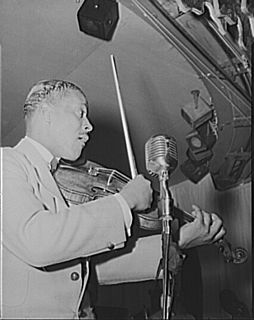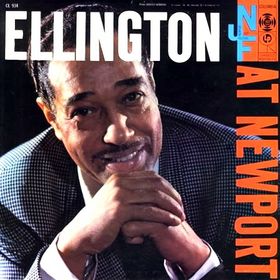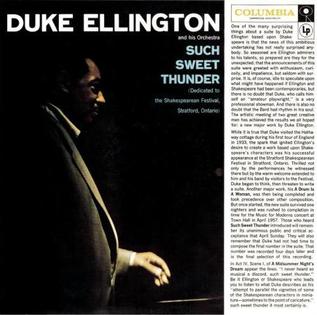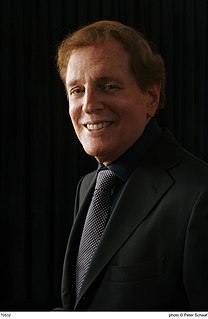Related Research Articles
An American in Paris is a jazz-influenced orchestral piece by American composer George Gershwin first performed in 1928. It was inspired by the time that Gershwin had spent in Paris and evokes the sights and energy of the French capital in the 1920s.

Edward Kennedy "Duke" Ellington was an American composer, pianist, and leader of a jazz orchestra, which he led from 1923 until his death over a career spanning more than six decades.

Ray Willis Nance was a jazz trumpeter, violinist and singer. He is best remembered for his long association with Duke Ellington and his orchestra.

Ellington at Newport is a 1956 live jazz album by Duke Ellington and his band of their 1956 concert at the Newport Jazz Festival, a concert which revitalized Ellington's flagging career. Jazz promoter George Wein describes the 1956 concert as "the greatest performance of [Ellington's] career... It stood for everything that jazz had been and could be.". It is included in the book 1001 Albums You Must Hear Before You Die, which ranks it "one of the most famous... in jazz history". The original release was partly recreated in the studio after the Ellington Orchestra's festival appearance.

William Alonzo "Cat" Anderson was an American jazz trumpeter known for his long period as a member of Duke Ellington's orchestra and for his wide range, especially his ability to play in the altissimo register.
Nadine Dana Suesse was an American musician, composer and lyricist.
Black, Brown and Beige is an extended jazz work written by Duke Ellington for his first concert at Carnegie Hall, on January 23, 1943. Ellington introduced it at Carnegie Hall as "a parallel to the history of the Negro in America." It was Ellington's longest and most ambitious composition.
Will Vodery was an African-American composer, conductor, orchestrator, and arranger, and one of the few black Americans of his time to make a name for himself as a composer on Broadway, working largely for Florenz Ziegfeld.

Such Sweet Thunder is a Duke Ellington album, released in 1957. The record is a twelve-part suite based on the work of William Shakespeare.
Jeff Tyzik is an American conductor, arranger, and trumpeter. He has recorded jazz albums as a soloist and arranged pop and jazz music for orchestras.
Orchestral jazz is a jazz genre that developed in New York City in the 1920s. Early innovators of the genre, such as Fletcher Henderson and Duke Ellington, include some of the most highly regarded musicians, composers, and arrangers in all of jazz history. The fusion of jazz's rhythmic and instrumental characteristics with the scale and structure of an orchestra, made orchestral jazz distinct from the musical genres that preceded its emergence. Its development contributed both to the popularization of jazz, as well as the critical legitimization of jazz as an art form.
This is the discography of Duke Ellington. Most of these recordings are listed by the year they were recorded rather than year released. Reissues are listed for most of the recordings released before the 1950s, as the original 78s are rare. The US chart listing information should be considered tentative because sources like the Joel Whitburn's Pop Memories does not take the cheaper dime-store records into account. During this period, records sold by song title, not by artist, although there are exceptions.
Maurice Peress was an American orchestra conductor, educator and author.
Genesis Suite is a 1945 work for narrator, chorus and orchestra. A musical interpretation of the first eleven chapters of the Book of Genesis, the suite was a collaborative work by seven composers, some of whom wrote film music in Hollywood. The project was conceived by Nathaniel Shilkret, a noted conductor and composer of music for recording, radio and film. Shilkret wrote one of the seven pieces and invited the remaining composers to submit contributions as work-for-hire. Two giants of western twentieth-century music, Arnold Schoenberg and Igor Stravinsky wrote, respectively, the first and last parts. The Biblical text used in the spoken word narrative is the American King James Version. It was intended to be a crossover from art music to popular music.

Masterpieces by Ellington is the first LP album by American pianist, composer, and bandleader Duke Ellington, recorded for the Columbia label in 1950. It was one of the earliest 12-inch LPs to take advantage of the extended time available and consisted of four tracks, three of them "concert arrangements" of Ellington standards and one, "The Tattooed Bride," a recent tone poem.

Ellington Uptown is an album by American pianist, composer and bandleader Duke Ellington recorded for the Columbia label in 1951 & 1952. The album was re-released on CD in 2004 with additional tracks recorded in 1947 and originally released as the Liberian Suite EP.

Symphony in Black: A Rhapsody of Negro Life is a nine-and-a-half minute musical short produced in 1935 that features Duke Ellington’s early extended piece, "A Rhapsody of Negro Life". The film, Billie Holiday’s screen debut, was directed by Fred Waller and distributed by Paramount Pictures.

Steven Richman is an American conductor and writer. He is music director of Harmonie Ensemble/New York, which he founded in 1979, and the Dvořák Festival Orchestra of New York.
Harmonie Ensemble/New York is a musical organization based in New York City that performs and records an eclectic repertoire ranging from classical to jazz. Founded in 1979 by its conductor, Steven Richman, HE/NY has performed orchestra, chamber orchestra, symphonic jazz, big band, chamber, and wind ensemble works in virtually all of New York's concert halls, including Carnegie Hall, Alice Tully Hall at Lincoln Center, Merkin Concert Hall, and St. Peter's Church, and throughout the United States under Columbia Artists Management. It also appears on radio and television. HE/NY has won numerous awards, including the Classical Recording Foundation Award in Carnegie Hall, Lincoln Center Community Arts Project, and the WQXR Action for the Arts Award, as well as a Grammy nomination.

Arias and Barcarolles is a 78-minute contemporary classical studio album of music by Leonard Bernstein, performed by Thomas Hampson, Frederica von Stade, Simon Carrington, Neil Percy and the London Symphony Orchestra under the direction of Michael Tilson Thomas. In addition to the song cycle which gives it its name, the album includes the Suite from Bernstein's opera A Quiet Place and the Symphonic Dances from his musical West Side Story. It was released in 1996.
References
- ↑ Hasse, John Edward, Beyond Category: The Life and Genius of Duke Ellington, Da Capo Press: New York, 1995, p. 297.
- ↑ Liner notes to Chandos Records CHAN 9226
- ↑ Ellington, Edward Kennedy (1976) Music is My Mistress, Da Capo Press ISBN 978-0306800337, p. 189